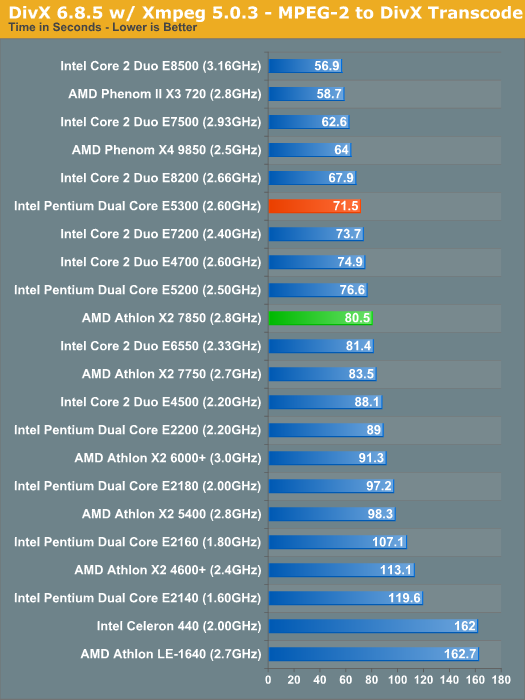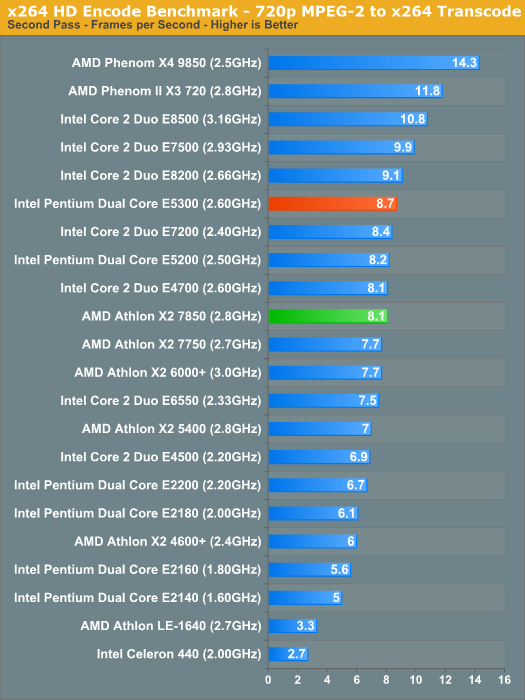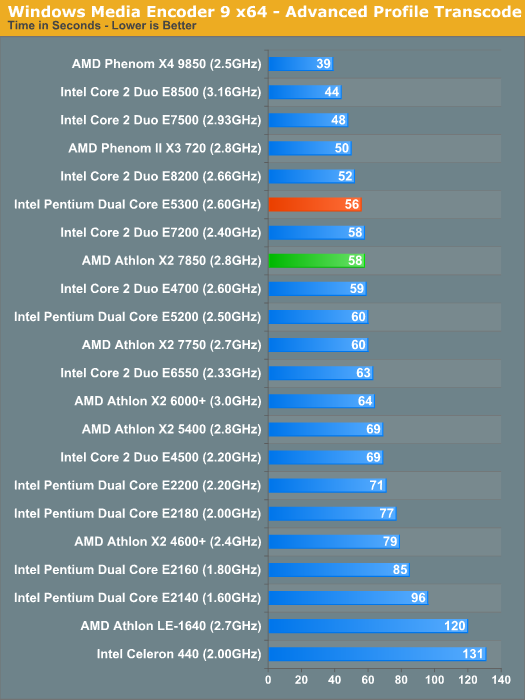AMD Athlon X2 7850 vs. Intel Pentium E5300: Choosing the Best $70 CPU
by Anand Lal Shimpi on April 28, 2009 11:00 AM EST- Posted in
- CPUs
DivX 8.5.3 with Xmpeg 5.0.3
Our DivX test is the same DivX / XMpeg 5.03 test we've run for the past few years now, the 1080p source file is encoded using the unconstrained DivX profile, quality/performance is set balanced at 5 and enhanced multithreading is enabled:

The original Phenom was significantly weaker than Intel’s Core 2 at DivX encoding, thus the Athlon X2 vs. Pentium comparison here isn’t very favorable for AMD. The E5300 is 11% faster than the 7850 here. Even the E5200 is a better choice for DivX encoding.
x264 HD Video Encoding Performance
Graysky's x264 HD test uses the publicly available x264 codec (open source alternative to H.264) to encode a 4Mbps 720p MPEG-2 source. The focus here is on quality rather than speed, thus the benchmark uses a 2-pass encode and reports the average frame rate in each pass.


The x264 HD encode test is slightly different depending on what pass you look at. The first pass of the x264 HD encode actually has a number of unaligned loads, which penalizes Intel’s Core architecture - something fixed in Nehalem. The second and more CPU intensive pass is where Intel sees a 7.4% performance advantage over AMD. Despite the small advantage in the first pass of the encode, the win goes to Intel for a larger and more meaningful advantage in the second pass.
Windows Media Encoder 9 x64 Advanced Profile
In order to be codec agnostic we've got a Windows Media Encoder benchmark looking at the same sort of thing we've been doing in the DivX and x264 tests, but using WME instead.

Our final pure encode test once again has the E5300 ahead of the Athlon X2 7850, but by only a 3.4% margin.










55 Comments
View All Comments
JimmiG - Tuesday, April 28, 2009 - link
Interesting to see the X4 9850 at 2.5GHz beating the higher clocked Phenom-derived Athlon X2 in many of the game tests. If multithreaded performance of games continue to improve, I think a Quad or Triple core CPU would be more future proof?The Phenom II X3 is a very nice AMD gaming CPU at this time and a tempting "sidegrade" even though I've already got a first-generation Phenom X4.
Davelo - Tuesday, April 28, 2009 - link
and then totally ignores it's original premise. I'm no fanboy but I find it very hard to miss the fact that the Intel solution costs almost $150 more when you factor in the added cost of the motherboard.Anand Lal Shimpi - Tuesday, April 28, 2009 - link
I used the X48 simply to allow for direct comparisons to all of the other CPU test data in Bench - www.anandtech.com/bench. The X48 performs similarly to the P45 and the P35 (and many other similar chipsets if you're not overclocking), so the comparison is still valid.Take care,
Anand
lopri - Tuesday, April 28, 2009 - link
What about power consumption comparison? Are you penalizing E5300 with X48 there? That'd be incredibly stupid and unfair to E5300.And this paragraph makes no sense to me. (literally)
Interesting review, nevertheless.
TA152H - Tuesday, April 28, 2009 - link
What he was trying to say was, the ideal cache set up for a quad-core is different from a dual-core. The quad-core is best with a relatively small and fast L2 cache, and a significantly larger L3 cache. The dual core is best with a relatively large L2 cache, and no L3 cache. Because AMD's processor is a quad-core stripped down to a dual-core, it has the cache hierarchy of the quad-core, even though it's a dual core now. So, it's not the ideal cache setup.edogawaconan - Tuesday, April 28, 2009 - link
Also worth noting that not all lower-end Intel processor includes VT-x which (arguably?) helps accelerating speed for tasks related to virtualization.stmok - Wednesday, April 29, 2009 - link
Actually, Intel's VT or AMD-V doesn't do much for performance. (You'll see this with VirtualBox. What it does provide is a more stable development approach to virtualization for the software programmer.)The one area where you will see a performance increase is with "nested paging". (A 2nd generation virtualisation feature).
In that case, the Phenom-based Athlon X2 clearly wins. NONE of the Core 2 series have nested paging, only Core i7 series...And this Core 2 doesn't have Intel VT either! Nested paging was introduced in all K10 based AMD CPUs. (Its also carried onto K10.5 or Phenom II processors).
nvmarino - Tuesday, April 28, 2009 - link
Considering the low price and low FSB/high multiplier of the E5300 makes it a perfect candidate for overclocking I'm surprised you guys didn't do some OC tests. Would be nice to see the impact of smaller cache at higher clocks.My e5300 does 3.7Ghz easily with a PoS air cooler.
aeternitas - Tuesday, April 28, 2009 - link
I think this review needs to be augmented with OC capabilities and the tests redone with them.Its highly unrealistic to test these at stock. The mass majority of people that would care about this review at this price are getting these cpus because of the insane bargain when OCed.
To not test that is really unrealistic. It makes this whole article much less usefull than it could have been.
nubie - Tuesday, April 28, 2009 - link
I went for the e5200 for $59 on ebay. Same chip but with a 12.5 multi instead of 13.I plan on running it well north of 3 ghz on a day to day basis, either 1066 or 1333 FSB. Even 1066 will get you a solid 3.4ghz, and it should be able to reach that easily on any motherboard.
You completely forgot to mention that this is the only 800mhz FSB line on a 45nm process, and thus can be overclocked in any motherboard, including $45 ones with a simple strap on the FSB pads.
I think that Intel is the clear winner, hands down, if you are an enthusiast with very little money who is not opposed to overclocking.